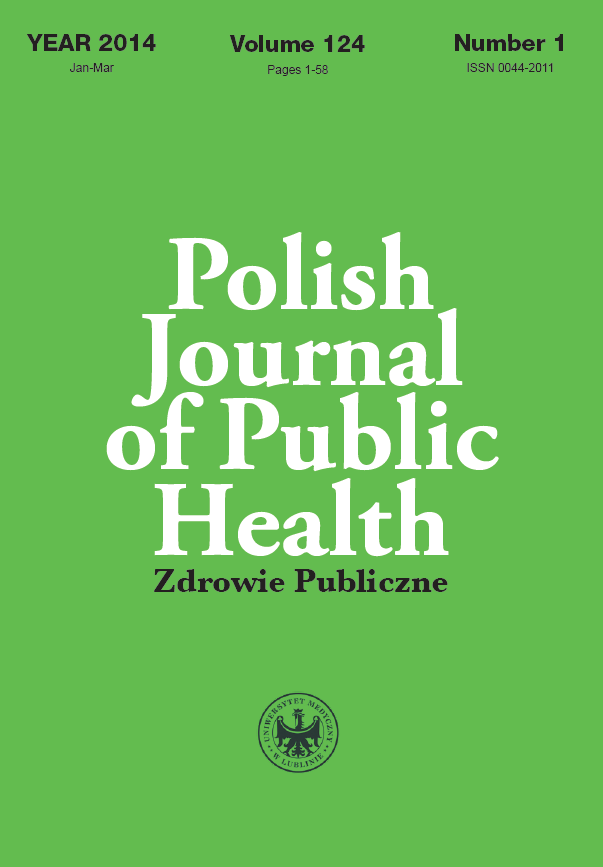The gene expression of class III inhibitors of apoptosis in arteriosclerotic disease
DOI:
https://doi.org/10.2478/pjph-2014-0008Keywords:
apoptosis, atherosclerosis, IAP, BIRC5 gene, BIRC6 geneAbstract
Introduction. Recent research shows that programmed cell death has great importance in the pathomechanism of atherosclerosis. The BIRC5 and BIRC6 genes belong to Class III IAPs with the anti-apoptotic effect. The proteins display multidirectional action. According to the available literature, in addition to the effect of apoptosis inhibition they also display other properties. It is suggested that they play an important role in the processes of proliferation and cellular differentiation.
Aim. The aim of the study was to assess the expression of the BIRC5 and BIRC6 genes in normal peripheral blood lymphocytes and in peripheral blood lymphocytes of patients diagnosed with atherosclerosis.
Material and methods. The analysis was carried out on RNA samples obtained from peripheral blood lymphocytes of 21 patients with diagnosed atherosclerosis. The specific fragment of the analysed gene was obtained through amplification with the use of cDNA synthesised in the reaction of reverse transcription. The test of expression was conducted with the use of the Real-Time PCR method. In the studied cases, the level of expression of the analysed gene was compared to the level of expression of the reference gene, B2M.
Results. The study showed that mRNA of the BIRC5 and BIRC6 genes is present in the cells of patients with atherosclerosis, as well as in the cells of healthy individuals. The cells taken from the patients with atherosclerosis were mainly characterized by an increased gene expression in comparison to the normal cells.
Conclusion. Increased BIRC6 and BIRC5 gene expression in the cells of the patients with atherosclerosis can suggest an increased amount of the inhibitor protein BRUCE and survivin, and also decreased sensitivity of cells to apoptosis. In the case of the patients who had significantly higher expression of the BIRC6 gene in lymphocytes compared to the norm, hypertension and diabetes mellitus were more common.
References
1. Urbanek T, Skop B, Wilczok T, et al. Apoptoza w schorzeniach układu naczyniowego – implikacje kliniczne, przegląd piśmiennictwa. Chir Pol. 2003;5:47-58.
2. Zapolska-Downar D, Sygitowicz G, Jarosz M. Znaczenie apoptozy w patogenezie miażdżycy. Kard Pol. 2008;66:347-57.
3. Stoneman V, Bennett M. Role of apoptosis in atherosclerosis and its therapeutic implications. Clin Sci. 2004;107:343-54.
4. Zagrodzki P. Łaszczyk P. Selen a choroby układu sercowo-naczyniowego – wybrane zagadnienia. Post Hig Med Dosw. 2006;60:624-31.
5. Mitrus I, Missot-Kolka E, Szala S. Geny proapoptotyczne w terapii genowej nowotworów. Współ Onkol. 2001;5:242-9.
6. Ghavami S, Hashemi M, Ande SR, et al. Apoptosis and cancer: mutations within caspase. J Med Genet. 2009;46:497-510.
7. Smolewski P, Grzybowska O. Regulacja procesu apoptozy komórek w celach terapeutycznych – dotychczasowe doświadczenia i perspektywy rozwoju. Acta Haematol Pol. 2002;33:393-401.
8. Wei Y, Fan T, Yu M. Inhibitor of apoptosis proteins and apoptosis. Acta Biochim Biophys Sin. 2008,4:278-88.
9. Malinowska I. Rola apoptozy w patogenezie i leczeniu nowotwór układu hematopoetycznego. Post Hig Med Dosw. 2004;58:548-59.
10. Korzeniowska-Dyl I. Kaspazy – struktura i funkcja. Pol Merk Lek. 2007;138:403-7.
11. Grzybowska-Izydorczyk O, Smolewski P. Rola białek z rodziny inhibitora apoptozy (IAP) w chorobach rozrostowych układu krwiotwórczego. Post Hig Med Dosw. 2008;62:55-63.
12. Stańczyk M, Majsterek I. Apoptoza – cel ukierunkowanej terapii przeciwnowotworowej. Post Biol Kom. 2008;35:467-84.
13. Rupniewska Z, Koczkodaj D, Wąsik-Szczepanek E. BRUCE/Apollon i jego rola w rodzinie białek hamujących apoptozę. Acta Haematol Pol. 2006;37:329-37.
14. Wright CW, Duckett CS. Reawakening the cellular death program in neoplasia through the therapeutic blockade of IAP. J Clin Invest. 2005;115:2673-8.
15. Deveraux QL, Reed JC. IAP family proteins suppressor of apoptosis. Genes Dev. 1999;13:239-52.
16. Bielak-Żmijewska A. Mechanizmy oporności komórek nowotworowych na apoptozę. Kosmos. Problemy Nauk Biologicznych. 2003;52:157-71.
17. Rumble JM, Duckett CS. Diverse function within the IAP family. J Cell Sci. 2008;121:3505-7.
18. Verhagen AM, Coulson EJ, Vaux DL. Inhibitor of apoptosis proteins and their relatives: IAPs and other BIRPs. Genome Biol. 2001;2(7):3009.
19. Grzybowska-Izydorczyk O, Smolewski P. Białka inhibitorowe apoptozy z rodziny inhibitorów apoptozy (IAP) i ich antagoniści: rola biologiczna oraz potencjalne znaczenie w karcinogenezie i celowanej terapii przeciwnowotworowej. Acta Haematol Pol. 2009;40:593-612.
20. Yang LY, Li XM. The IAP family: endogenous caspase inhibitors with multiple biological activities. Cell Res. 2000;10:169-77.
21. Kaczmarek-Borowska B, Zmorzyński Sz, Filip A. Biologiczna rola surwiwiny. Współ Onkol. 2008;10:437-40.
22. Rupniewska Z, Koczkodaj D, Wąsik-Szczepanek E. Ekspresja surwiwiny i jej znaczenie kliniczne (Część II). Acta Haematol Pol. 2005;36:381-7.
23. Yamamoto K, Abe S, Nakagawa Y, et al. Expression of IAP proteins in myelodysplastic syndromes trans forming to overt leukemia. Leuk Res. 2004;28:1203-11.
24. Sokołowska J, Urbańska K. Biologiczna rola surwiwiny i jej znaczenie kliniczne. Życie Wet. 2011;86:963-6.
25. Hansson GK, Libby P. The immune response in atherosclerosis: a double-edged sword. Nat Rev Immunol. 2006;6:508-19.


